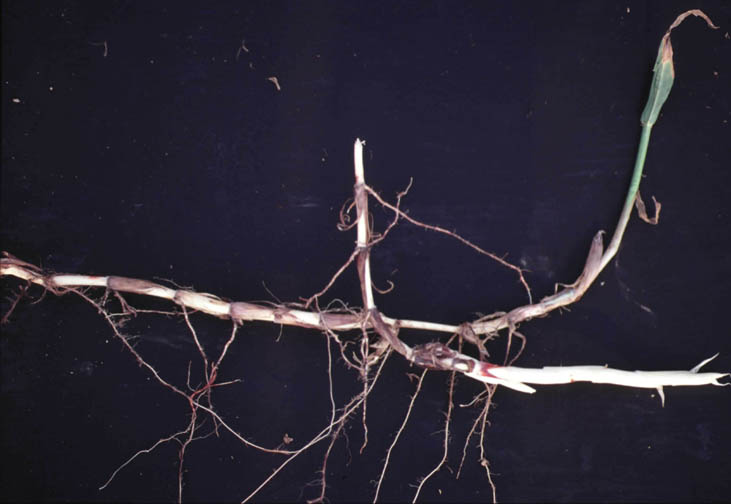Johnsongrass (Sorghum halepense)
Family:
Grass Family (Poaceae)
Other Names:
Andropogon halepensis, Holcus halepensis, Sorghum miliaceum, Egyptian millet, Egyptian-grass, false guinea-grass, grass sorghum, means-grass, millet-grass, Morocco millet.
Origin and Distribution:
Johnsongrass originated in southern Eurasia, and was brought to the southeastern U.S. in the 1800's as a forage crop. It was named after Colonel William Johnson, who introduced this species to his fertile river bottom farm in Alabama around 1840. Today, Johnsongrass is a weed in tropical and temperate climates throughout the world, and is considered among the world's 10 worst weeds. It has become naturalized throughout much of the U.S. and is spreading northward into Canada. Johnsongrass is a troublesome weed in Ohio, where it grows in crop fields, pastures, roadsides and banks of ditches and irrigated canals, preferring areas with rich soils. However, this species can tolerate a wide range of soil types and environmental conditions.
Plant Description:
Johnsongrass is a large, coarse, sod-forming perennial grass, characterized by its purplish, pyramidal flower heads and the prominent white midrib down the leaf blade. It reproduces by seeds and stout rhizomes (horizontal underground stems), and can form large, dense patches.
Root System:
Johnsongrass forms an extensive system of stout, creeping, fleshy rhizomes (horizontal underground stems) that can grow over 6 feet long. Rhizomes are whitish to brownish and may have purplish spots. The joints (nodes) of the rhizomes are covered with brown, scaly sheaths.
Stems:
Stems are stout, erect, round, hollow, unbranched (sometimes branched) and smooth, growing 3 to 8 feet tall (sometimes up to 10 feet).
Leaves:
Leaves are rolled in the bud and bright green, sometimes tinged with purple pigments when under stress. The leaf blade (free part of the leaf) (8 to 24 inches long, 1/2 to 1 inches wide) is hairless (sometimes with a few hairs at the base near the ligule), flat, smooth above, and rough below and on the margins. A prominent white midrib runs down the upper surface of the leaf blade, forming a pronounced keel along the back of the blade. The sheath (part of the leaf surrounding the stem) is smooth and usually round, but sometimes can be slightly flattened. Margins of the sheath overlap. The ligule (projection inside on the top of the sheath) is prominent (1/8 to 1/4 inch long) and membranous, often with a fringe of hairs along the top. Auricles (appendages at the top of the sheath) are absent.
Flowers:
The open, airy, pyramidal flower head (6 to 20 inches long, up to 8 inches wide) is composed of numerous whorls of branches, with the lower branches longer than the upper ones. Clusters of purplish flowers are produced along the branches. Initially, the branches are tight against the main stem, but spread open as the flower head matures.
Fruits and Seeds:
Seeds are reddish-brown, oval, and 1/8 inch long.
Similar Species:
Young plants of johnsongrass may resemble a narrow-leafed corn (Zea mays) plant. Seedlings of johnsongrass may be distinguished by the remnant seed attached to the root, and shoots may be distinguished by the presence of rhizomes. Johnsongrass and shattercane (Sorghum bicolor) are close relatives, but shattercane is an annual and does not produce rhizomes. In addition, the leaf blades of shattercane are much wider, and the seeds are larger and more rounded. Common reed (Phragmites australis) may resemble johnsongrass, but grows much taller and has dense, feathery flower heads and thin seeds.
Biology:
Johnsongrass flowers from May to July. This species can produce a large amount of seed. Over 28,000 seeds were produced from a single plant growing free of competition. Sixty to 75% of the seeds may still be viable after 2 1/2 years in the soil. Viable seeds can be found in cattle and bird droppings, though wind and water dissemination are probably the primary means of dispersal for this species. Most seedlings emerge from the top 3 inches of the soil, but emergence is possible from 6 inches.
With the aid of its rhizomes, johnsongrass can form dense, spreading patches. A single plant can produce up to 300 feet of rhizomes in one season. New stands readily establish from small pieces of rhizome.
Johnsongrass is very invasive and can reduce corn and soybean yields over 30% and 40% respectively, even with normal control efforts. Crop production is impossible in a dense johnsongrass stand if left uncontrolled. This species also serves as an alternate host for several insect, nematode and disease pests of desirable crops. Johnsongrass contains allelopathic compounds that inhibit the germination and development of various crop species. Some control may be obtained through repeated tillage and close mowing.
Johnsongrass is still used as a forage grass in the southeastern U.S. and other parts of the world. It can produce 2 or more crops of hay each year. It is similar to alfalfa in protein content and to timothy in feeding value. Forage quality increases with soil fertility and decreases with plant maturity. Its extensive rhizome system also makes it a valuable species for erosion control.
Toxicity:
Johnsongrass can produce toxic amounts of cyanide if growing under stressful conditions, such as cold (i.e. frost), extreme heat or drought. Poisoning and death of grazing animals may occur if large quantities of the leaves and stems are ingested. Nitrates can also accumulate in johnsongrass, resulting in toxicity to cattle. The airborne pollen may contribute to hay fever in the summer.
Facts and Folklore:
This species was the target of the first federal grant specifically for weed control in 1900.
Over 55 varieties of johnsongrass have been identified growing in the U.S. and Caribbean countries.

Johnsongrass rhizome.

Johnsongrass seedling.

A johnsongrass-infested corn field.

Johnsongrass collar region; note prominent midrib of leaf.

Johnsongrass inflorescence along roadside.

Johnsongrass seeds.
